DIY Raised Stencil on Furniture
Stop painting the same thing over and over. This unique stenciled furniture finish will set your painted furniture apart from the rest in no time! Check out this must-see tutorial on how to do a raised stencil on furniture. Get more painting techniques for furniture here!
Here is what the dresser looked like before we added the raised stencil and painted it. It was pretty beat up huh?
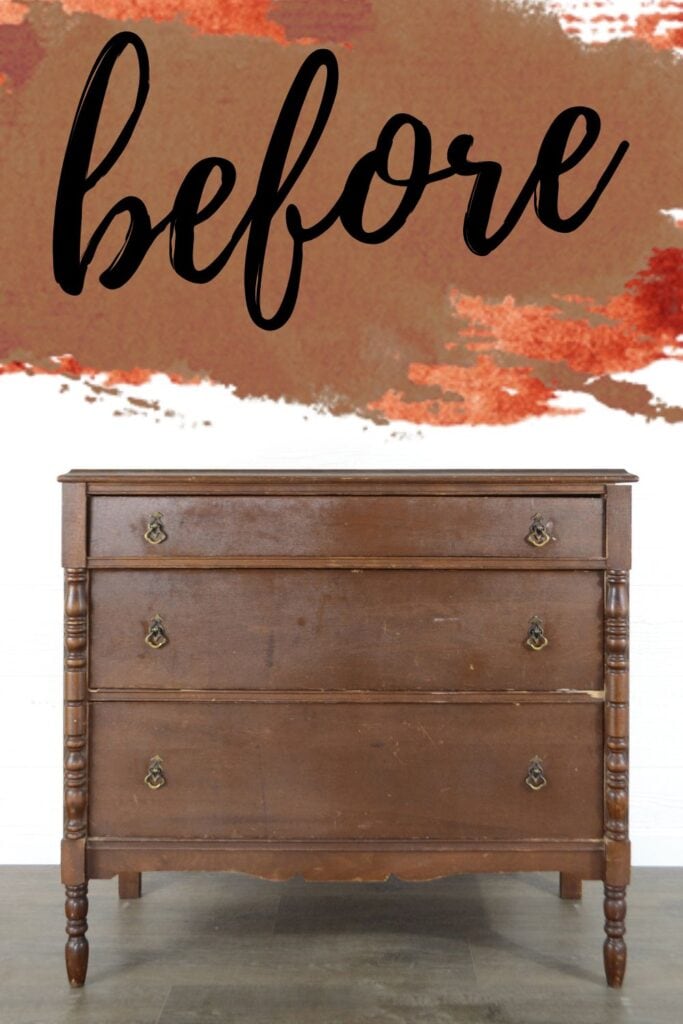
I’m sure you have seen details painted on furniture all over the place. Some people hand paint these details, and others use a stencil to paint details onto furniture.
We’re taking it one step further though by adding texture to those details, AND by tinting the texture brown so it looks like it is wood detailing. What does that even mean?
Well, you can use a stencil, some special powder, and some paint to make these stenciled details look like they are part of the dresser, and part of the wood.
That’s what is so unique about this painted furniture finish! Okay, so here’s how you can get this look.
Supplies Used For Raised Stencil on Furniture
As an Amazon Associate, I earn from qualifying purchases. I also may earn from other qualifying purchases with other companies or get free product to review and use. All opinions are my own.
- The Stencil – Donatella Damask Craft Stencil
- Texture Powder
- Dark Roast Paint
- Straight Edged Tool
- Paper or Plastic Bowl and Fork
- Painters Tape
- Behr Interior Flat White Paint
- Wagner Double Duty Paint Sprayer
- 220 Grit Sandpaper
- Tack Cloth
- Varathane Polyurethane
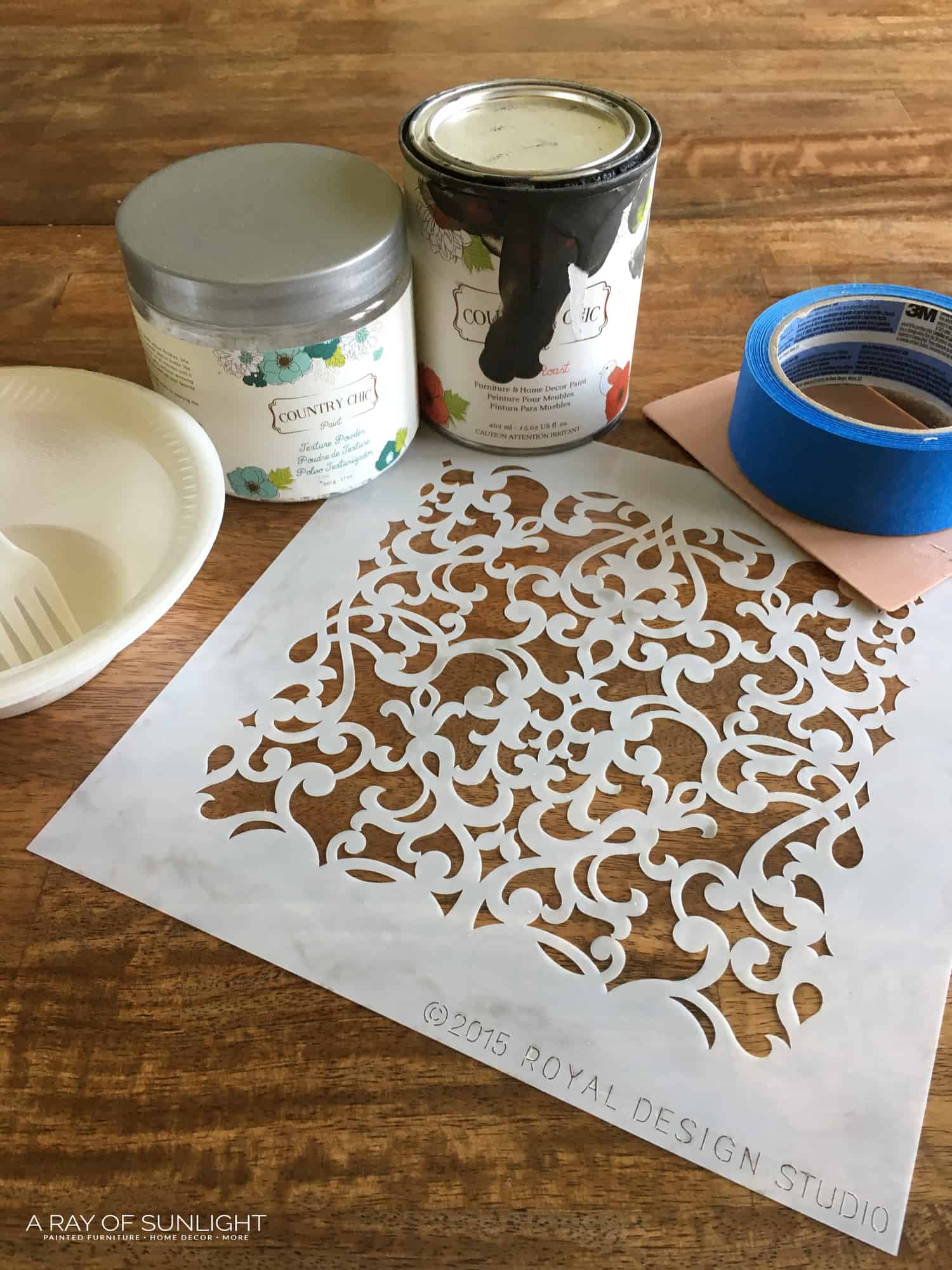
How to Choose the Best Stencil
I’ve created this finish many times with a different stencil each time. But you don’t want to pick just any old stencil. You’ll want a stencil that has a lot of small detail, and not so many straight lines.
Another thing to consider is the size of the stencil. You’ll want one that covers a lot of area, especially if you’re planning on adding texture to a lot of places on your furniture.
I personally love the 12″ x 12″ stencils, or stencils that are at least as wide as the drawers are tall.
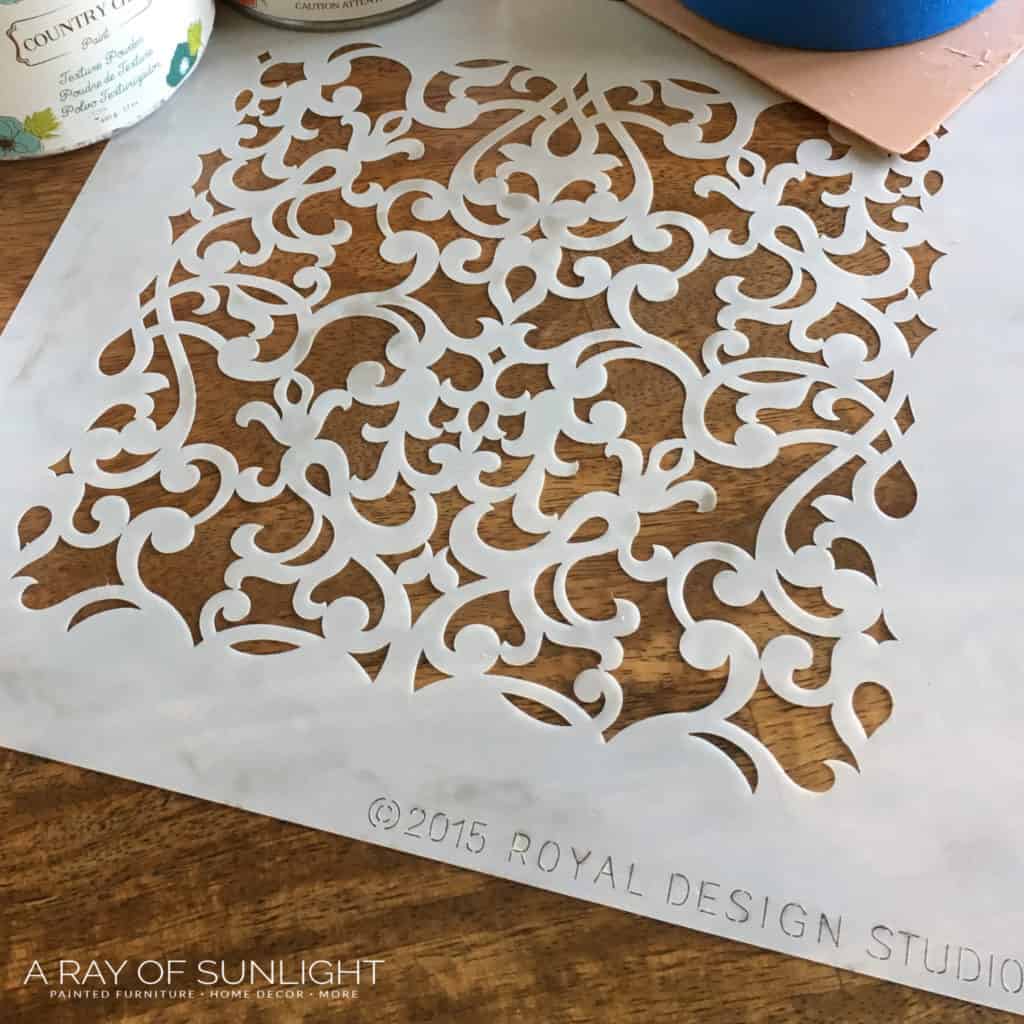
This particular one is smaller than most, but I fell in love with the pattern that I decided it was worth a little bit of extra work.
If you do get a smaller stencil, you’ll just have to keep moving it around until all of the area is covered, which isn’t a big deal.
It might take about 5 minutes longer to stencil everything that way.
DIY Raised Stencil with Texture Powder
There are so many reasons that I love the texture powder by Country Chic Paint. But first and foremost, I love that you can tint it whatever color you want by adding paint to it.
The powder is colorless, so it doesn’t change the color of the paint at all. So really, you could have a raised stenciled design in any color!
You could match it to the paint color you’re painting on the rest of the piece, or make it a fun color to really stand out. The possibilities really are endless.
I also love that it’s all natural, so I don’t have to worry about any harsh chemicals at all!
And, I love how versatile it is. You can dabble it onto wood to create a weathered texture finish, or you can mix some without paint to create spackling to fill in small holes in the wall.
(I also want to try it for hiding wood grain.)
Here’s another method for adding texture to your furniture, check out my post about how to decoupage furniture with rice paper.
Choosing Stencil Placement
Okay, you have your products, and you have prepped furniture for painting. Now it’s time to create your stenciled furniture finish.
I personally love to add an overall raised stencil finish to the drawer fronts of dressers or nightstands. And then I leave the rest of the furniture without texture.
But, I have also used a single stencil to add a circular detail to a cabinet door, making it look like a wood applique or carved detail. The concept or process is the same either way.
First it’s best to decide the placement of the stencil.
So, I decide if I want it to be exactly centered in the very middle of the drawer, or if I want it centered lengthwise, but maybe have the center of the stencil up just a bit, so it doesn’t look too perfect.
For this stencil and dresser, I found the center of each drawer’s length. When I placed the stencil, I put it in the exact center, and then I moved it up just a bit so it wasn’t in the exact center.
Once you’ve decided on where you want it, tape the edges just a bit with painters tape to keep the stencil from moving.
**It’s best to start in the middle of the drawer and work out, just so you have the same details all the way around the drawer.
How to Make Raised Stencil on Furniture
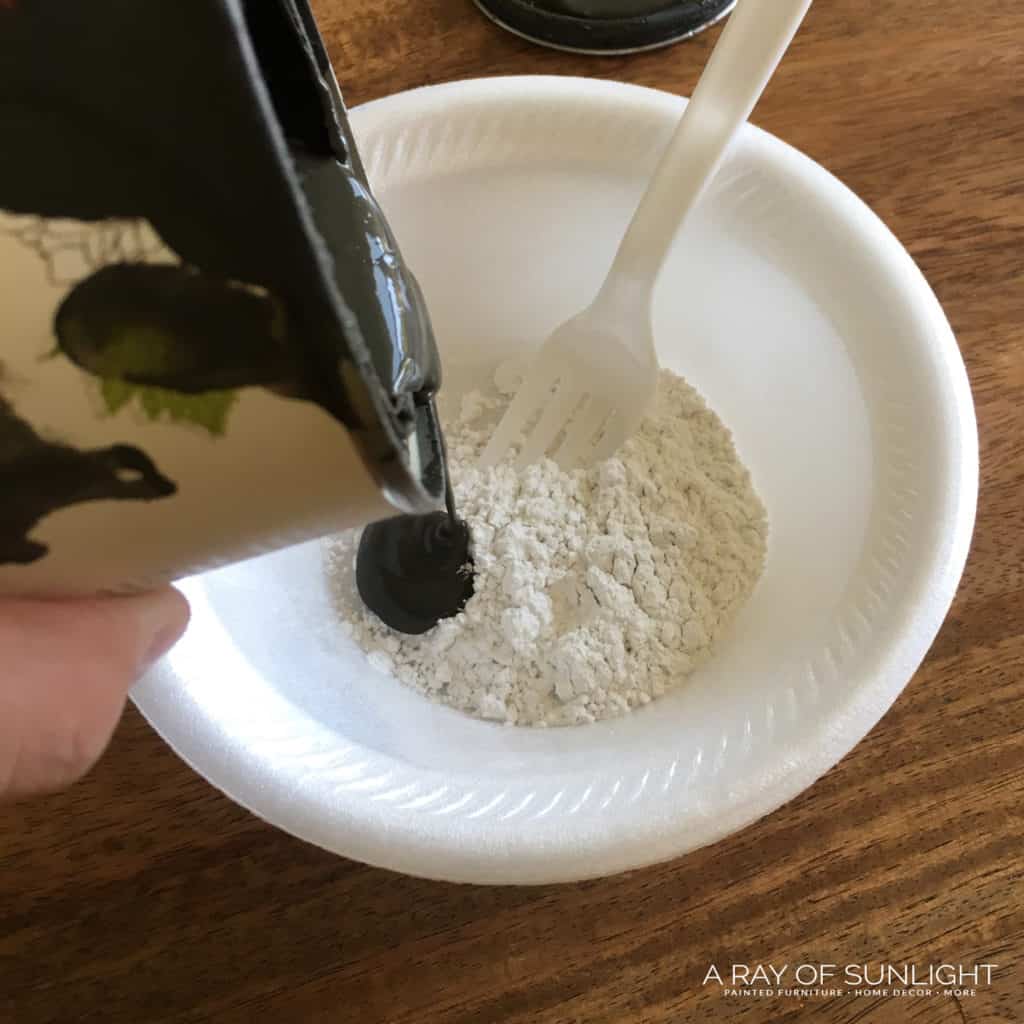
Mixing the texture powder and paint is super easy. Just use an approximate 1:1 ratio of powder to paint.
To be honest, I never measure. I just pour some paint into a paper or plastic bowl, then I pour about the same amount of texture powder on top.
I use a plastic fork or spoon to mix the two together, making sure that there aren’t any clumps of powder. You’ll want it to be the consistency of peanut butter at room temp.
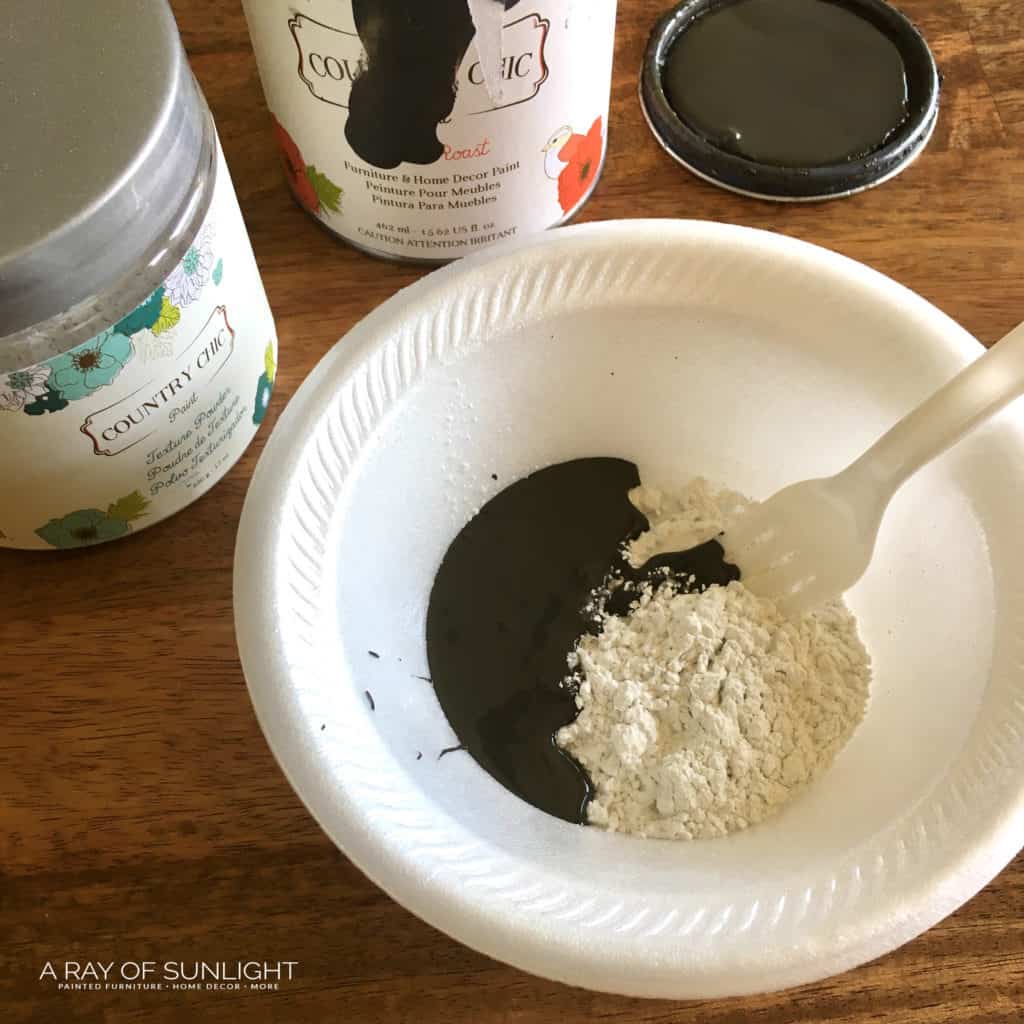
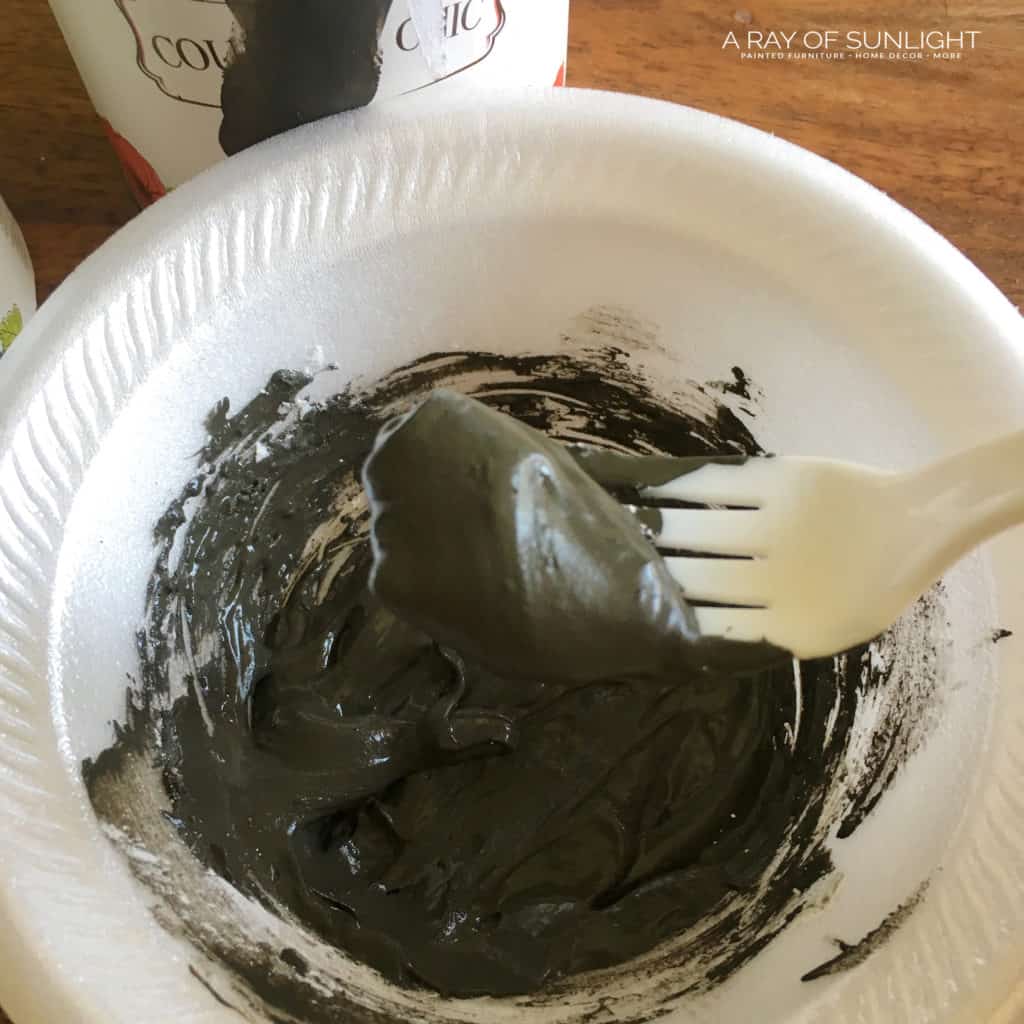
The texture powder will dry out if it’s left uncovered for a while. I only mix a small amount at a time, and then I put a damp paper towel and tin foil tightly wrapped over the bowl if I leave it.
Now it’s time to spread the texture all over! Just grab a straight-edged tool, put a little bit of texture paste on it, and then spread it all over the stencil.
You don’t want to get the texture too thick, and you don’t want it to go under the stencil. So it’s best to work with a small amount at a time. Check out how to stencil without bleeding here.
Make sure to get it into all of the details, and then spread the texture so it’s flat and smooth.
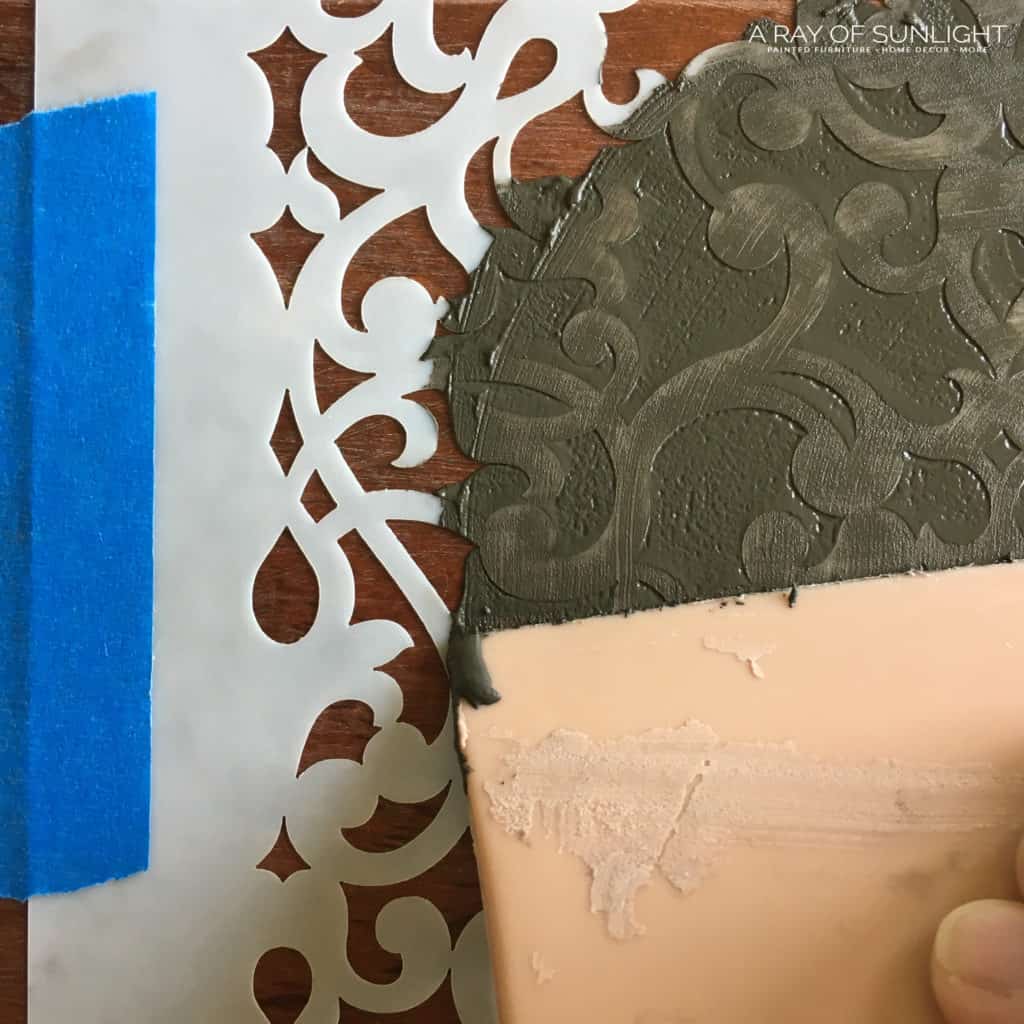
Work in small sections, and then lift the stencil, line it up, and lay it down on the next area. Just be sure to not ruin the texture you’ve already laid down.
You may need to take the tape off at this point so it doesn’t get in the way, but you’ll want to hold the stencil in place with your fingers. You can also wait for that section to dry before moving on.
Once the texture is completely spread across the drawer front, leave it to dry completely. I leave mine overnight.
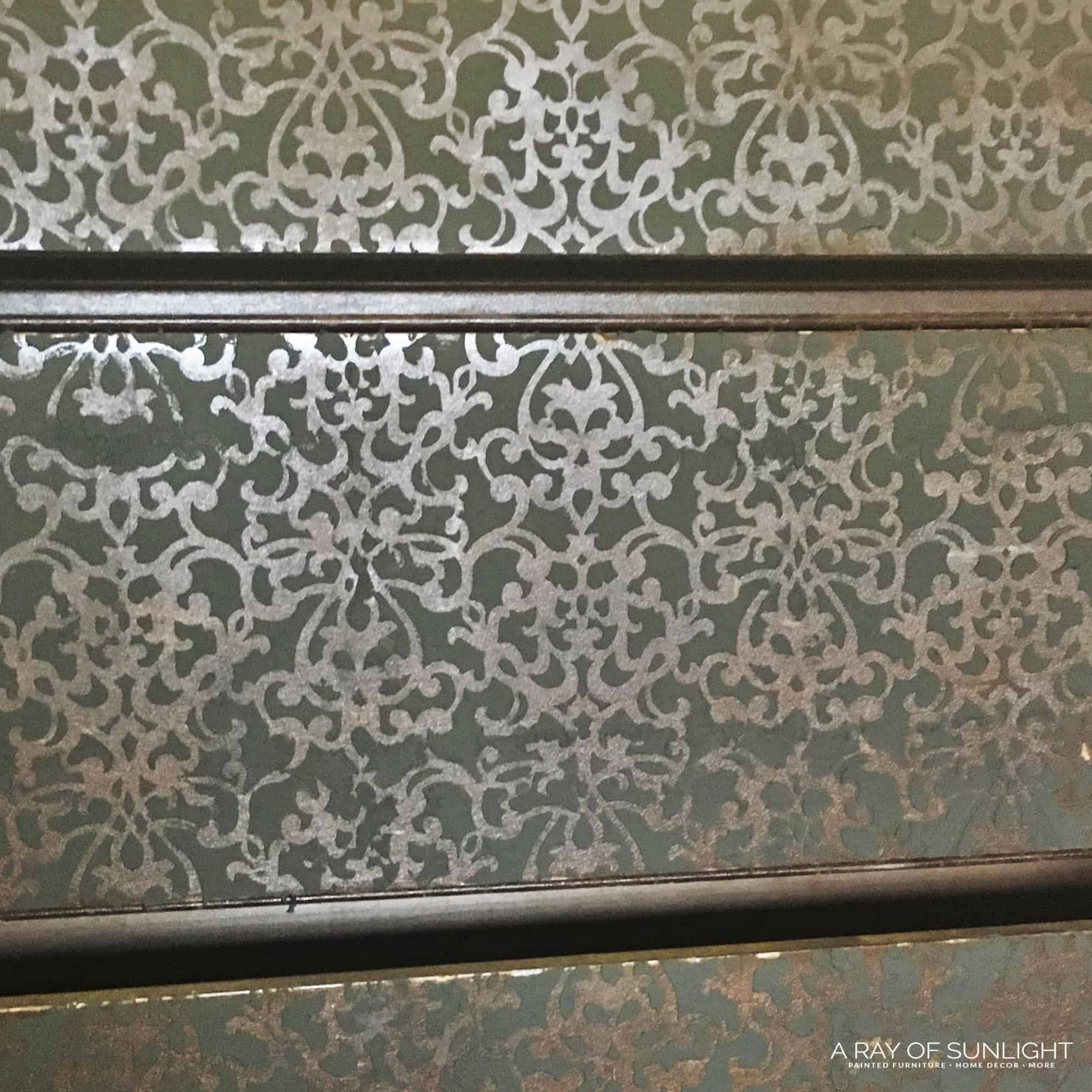
And don’t worry, if you mess up, grab a wet rag and wipe it off. You may even be able to wipe it off the next day with a little bit of elbow grease, water, and a rag.
Chalk Painting Stenciled Dresser
Once the texture is dry, it’s time to paint! For this dresser, we used a creamy white paint called Heavy Cream in Behr Interior Flat Paint.
Then I used our favorite homemade chalk paint recipe to create chalk paint. I really love making my own chalk paint because I hate to be limited in my color choices.
Check out some more options for the best white paint for furniture.
But, I really love the feel of chalk paint and how it distresses.
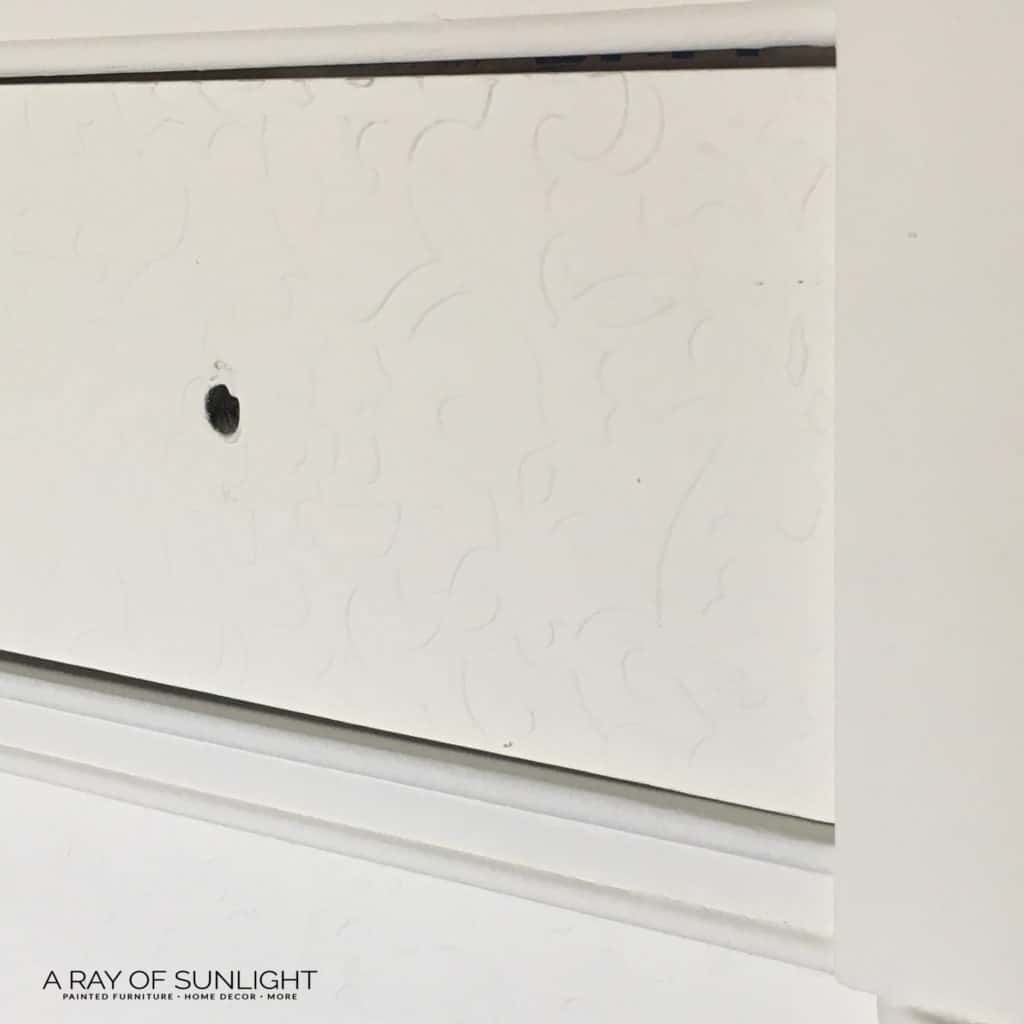
Per usual, I sprayed the paint on with my favorite paint sprayer, the Wagner Double Duty paint sprayer, the cheap and easy-to-use one that doesn’t even need an air compressor or anything extra!
Check out this post to learn all about the best HVLP paint sprayers for furniture!
It really makes painting whites and creams so much easier. Actually, it makes painting any color so much easier!
Here’s where you can find more information about how to use a paint sprayer, and the steps I take every time to prevent overspray and avoid getting paint everywhere!
If you want to brush or roll your paint on instead, you can. Here are the best paint brushes for painting furniture and the best rollers for painting furniture.
Distressing Stenciled Dresser
After the paint is dry, it’s time to distress to really make the stenciled texture pop! It’s really simple actually. I usually take a small piece of 220 grit sandpaper and wrap it around an old sanding block.
Then I go to town lightly sanding all of the texture. The edges of the texture will start to show up brown, making it look like distressed wood.
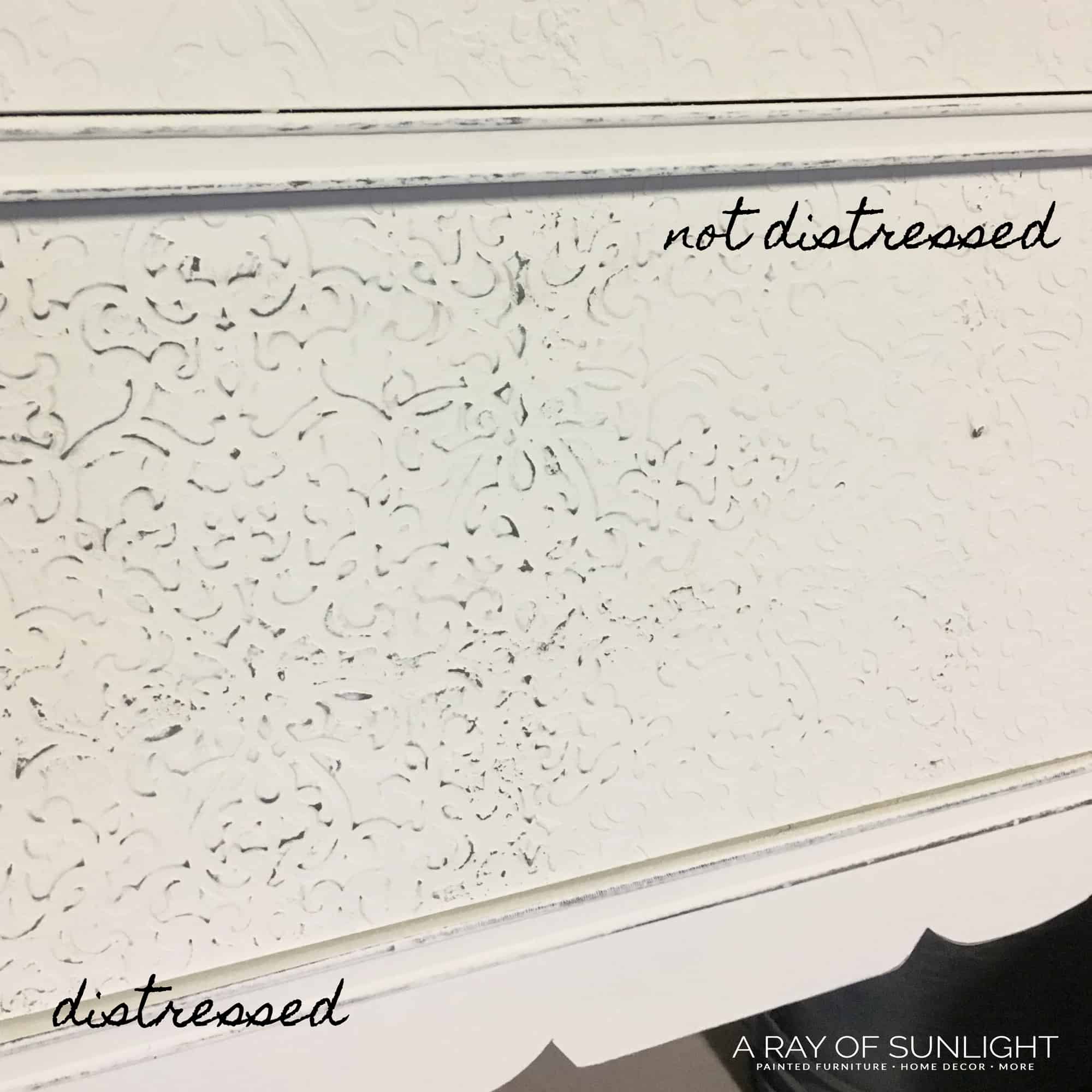
Once the texture is all distressed, I move on to distressing the body of the dresser. I like to distress it more heavily than usual, just because the drawers are distressed so much.
Check this post about distressing furniture to learn more about how to distress with chalk paint! And check out distressed painted furniture for more inspiration on your next furniture painting project.
Then it’s best to vacuum and wipe all of the dust off with a tack cloth and then seal the paint.
Sealing the paint really provides a durable finish and it makes the paint feel nice and smooth. I like to spray on 3 coats of this Varathane polyurethane to seal it.
Learn ALL of my tips and tricks on how to spray polyurethane here! If you don’t have a paint sprayer, here is how to apply polycrylic to painted furniture by hand.
Or learn about the many other alternative options for topcoats for painting furniture here!
Replacing Dresser Top
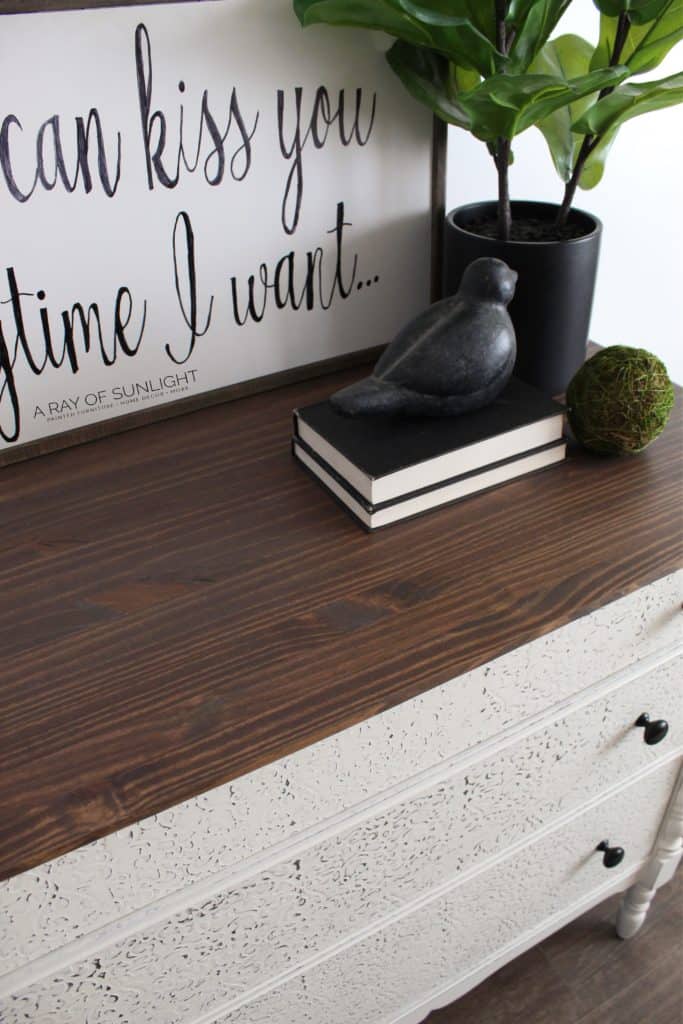
One last detail of this dresser makeover was the top. When we found the dresser, the top didn’t go all the way to the back of the dresser. That’s usually where a mirror or a backsplash would go.
So we grabbed a new piece of wood and replaced the top. Learn more about how to replace a dresser top in this black vintage farmhouse dresser makeover.
If you’re a visual learner, you can watch the process unfold on what was a LIVE Facebook video. But we recorded it so you can watch it over and over right here.
*There are a lot of details about painting furniture that I won’t cover in this tutorial. Just because I want to really focus on this specific stenciled dresser technique. Get more tips and tricks about painting furniture here.
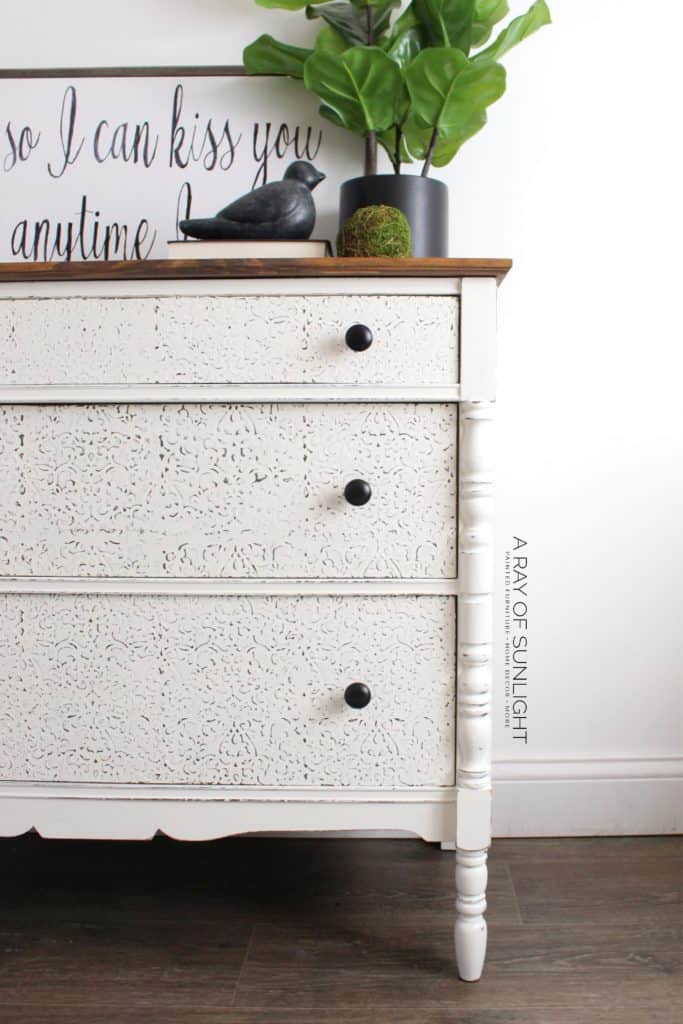
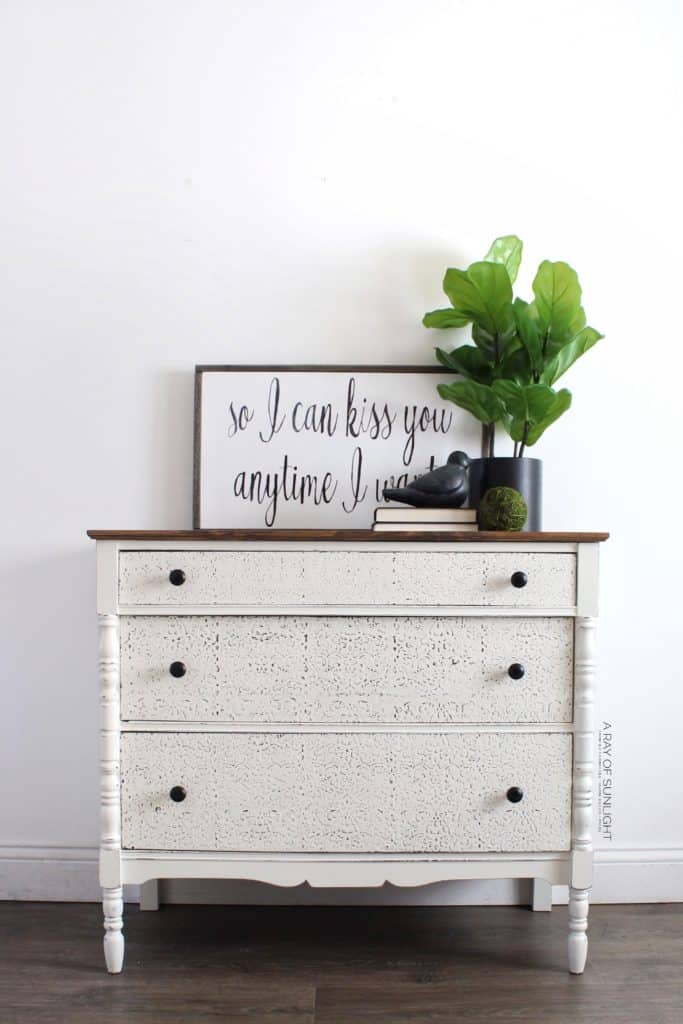
More Before And After Makeovers
Click any of these “before” photos below to view the “after” of that makeover.
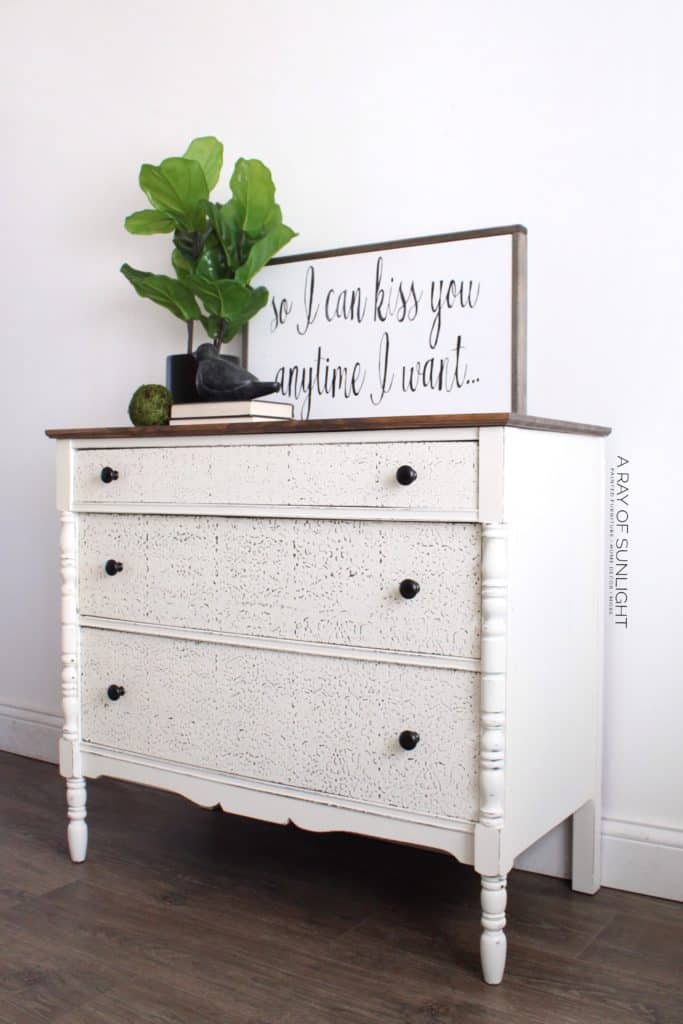
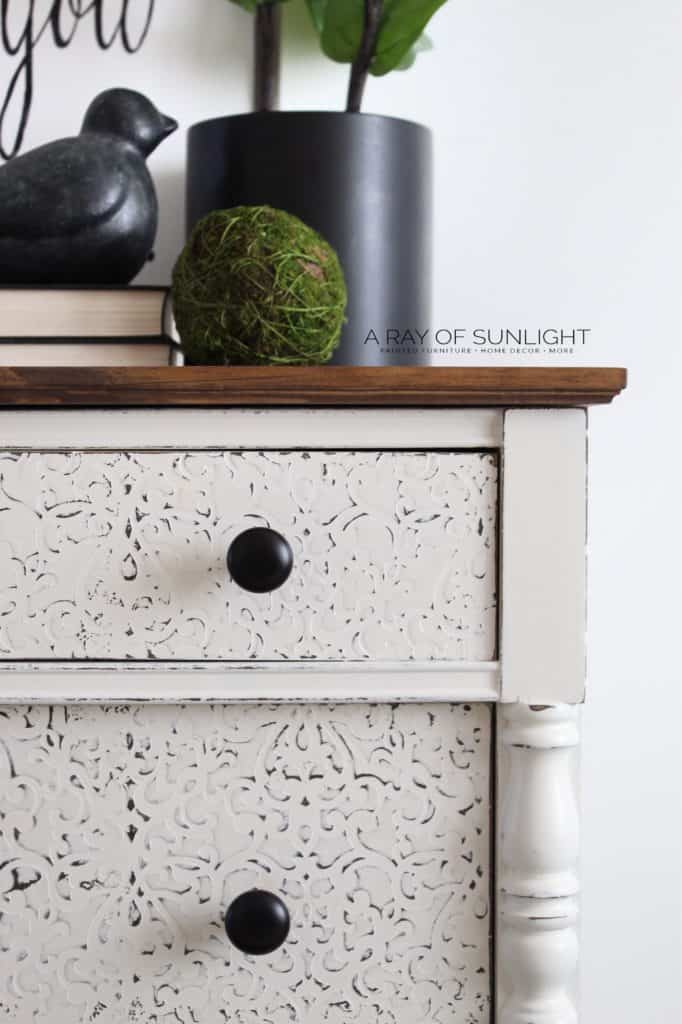
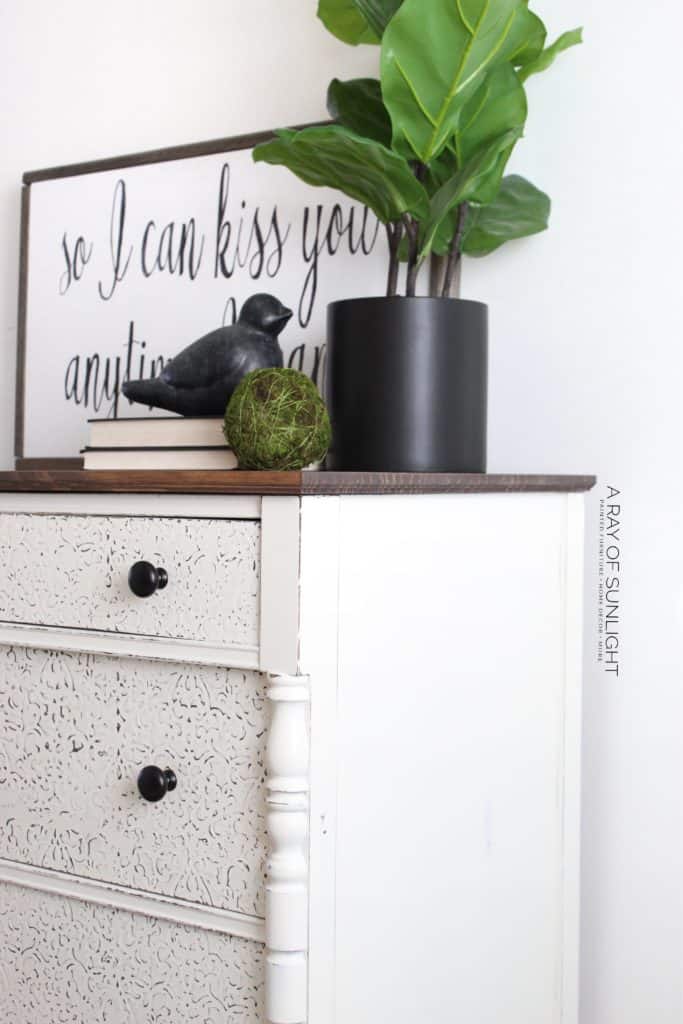
I hope you’ll try this technique! Please let me know if you do! Check out this post to learn all about stenciling furniture. And get more white painted dresser ideas here.
More Stencil Furniture Makeovers
- Shabby Chic End Tables with Raised Stenciling
- Navy Dresser with Textured Drawers
- Embossing Furniture
- Stenciled Furniture
- DIY Navy Chest of Drawers
Follow us on YouTube to get more tips for painting furniture.
Or share your project with us on our Facebook Group and be part of our community. See you there!

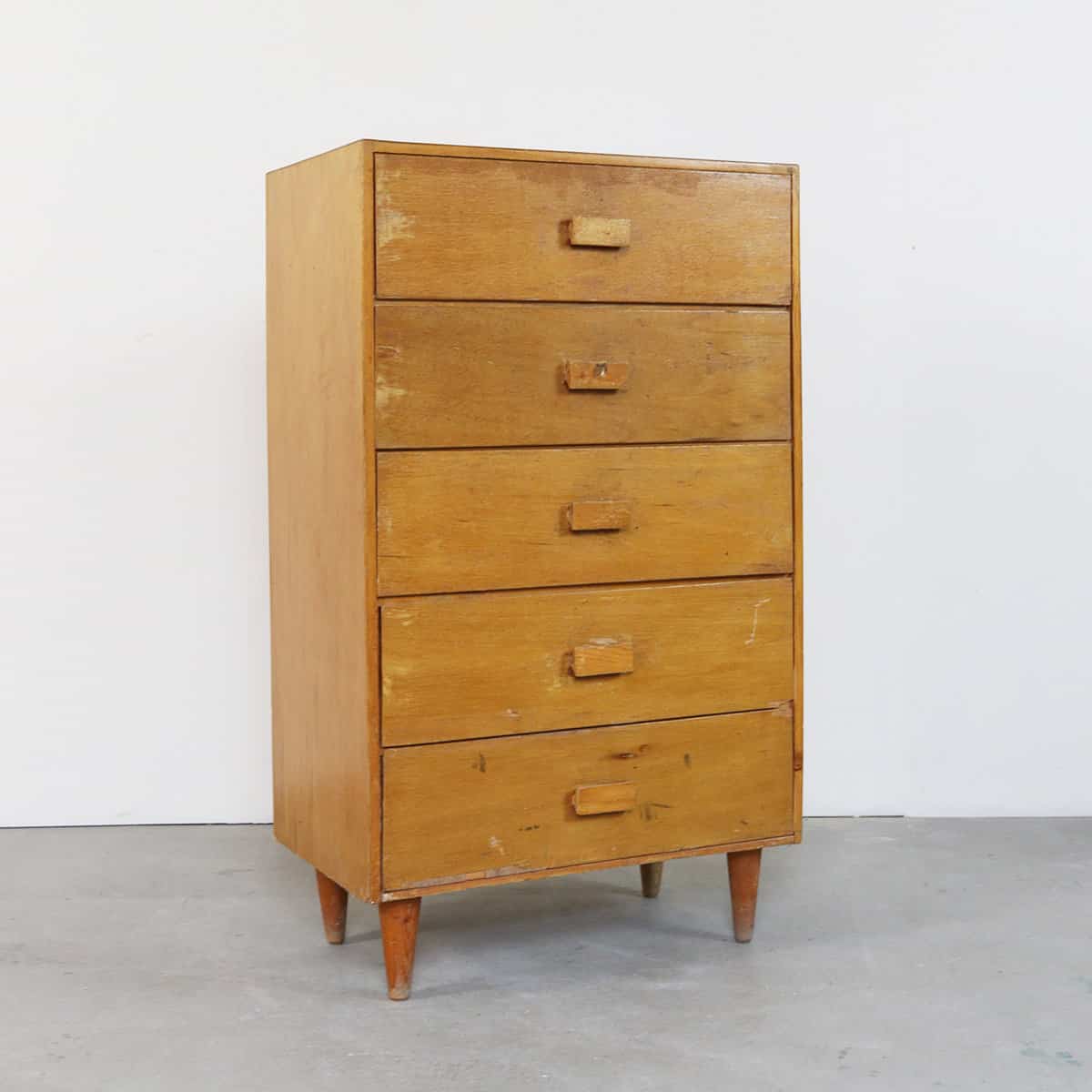
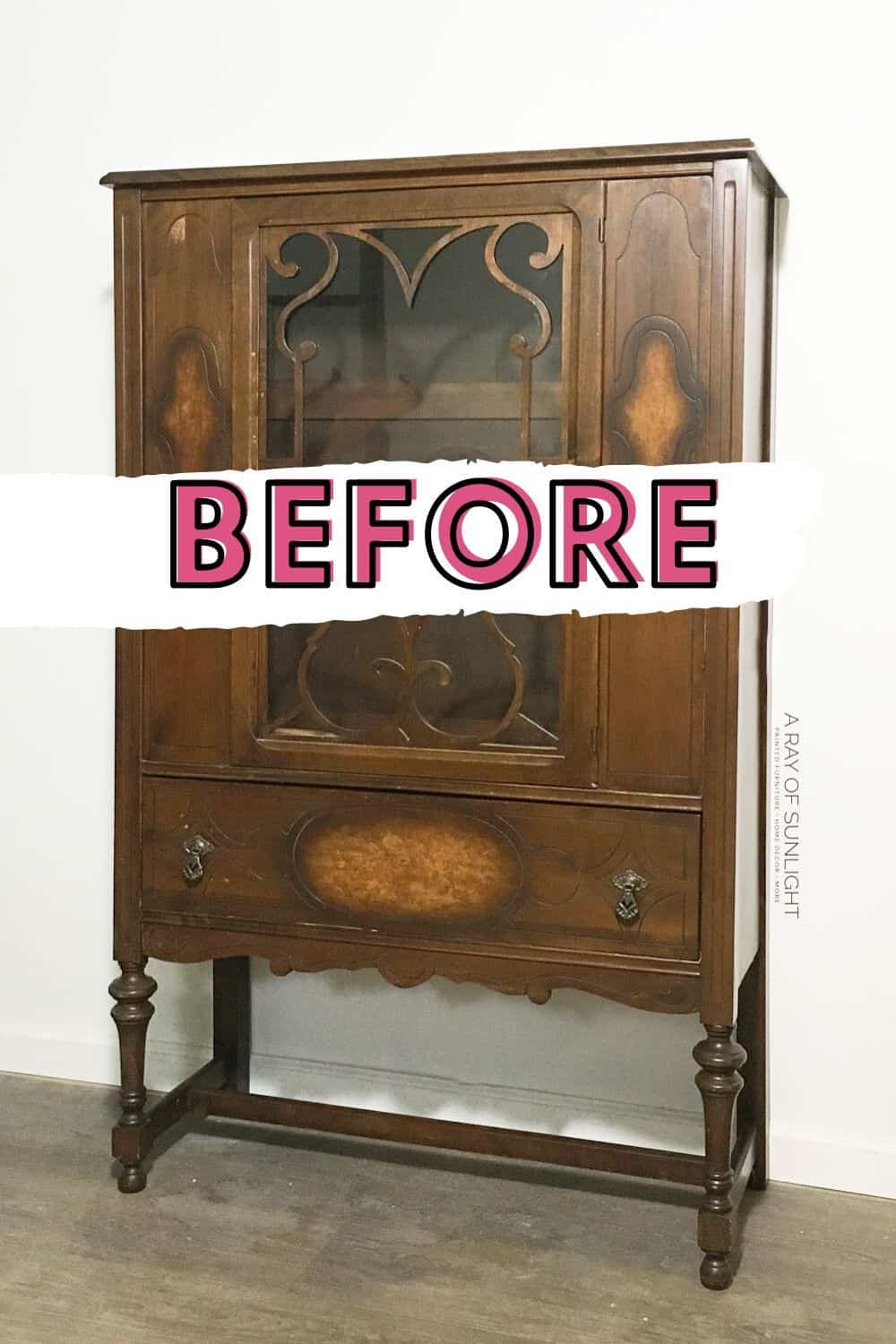
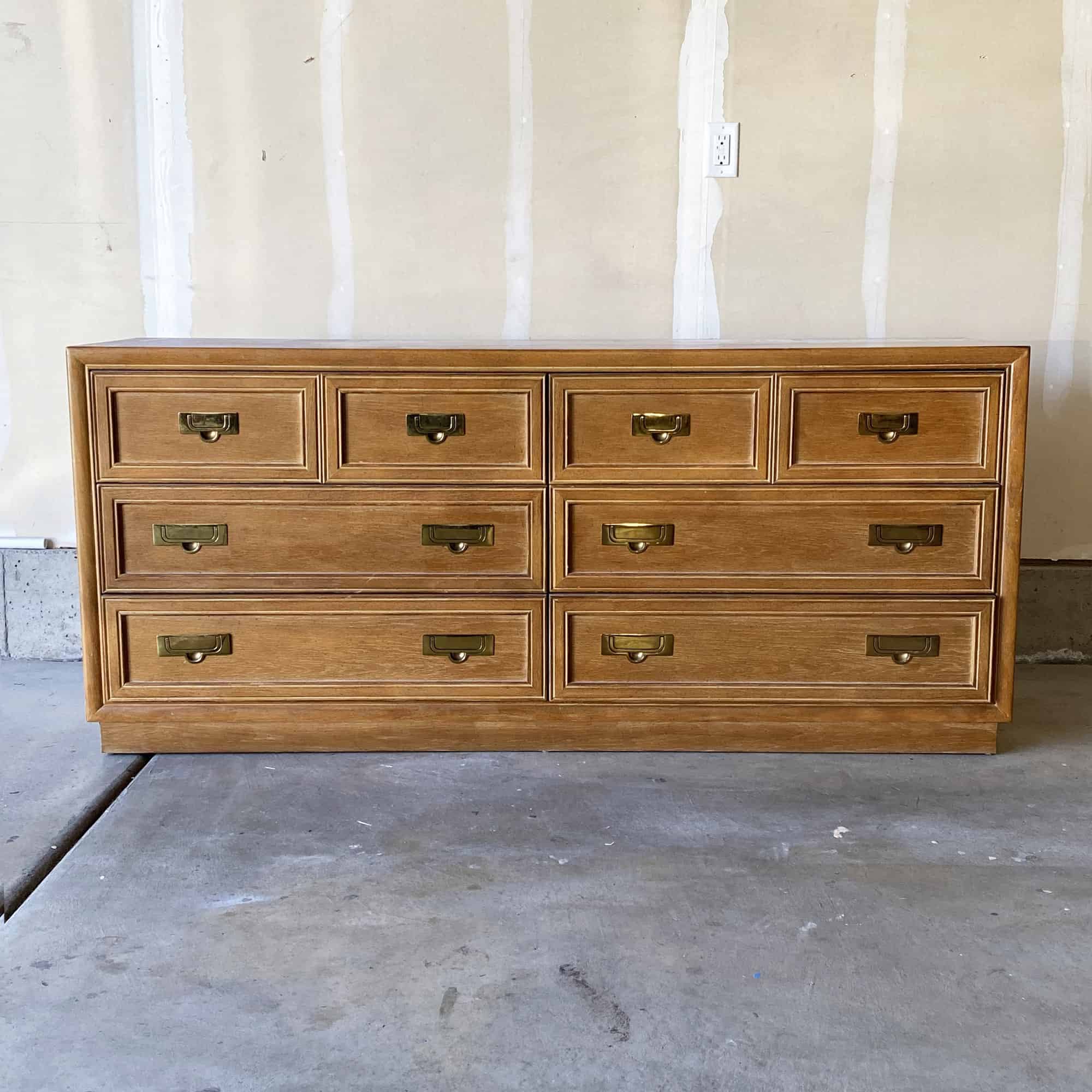
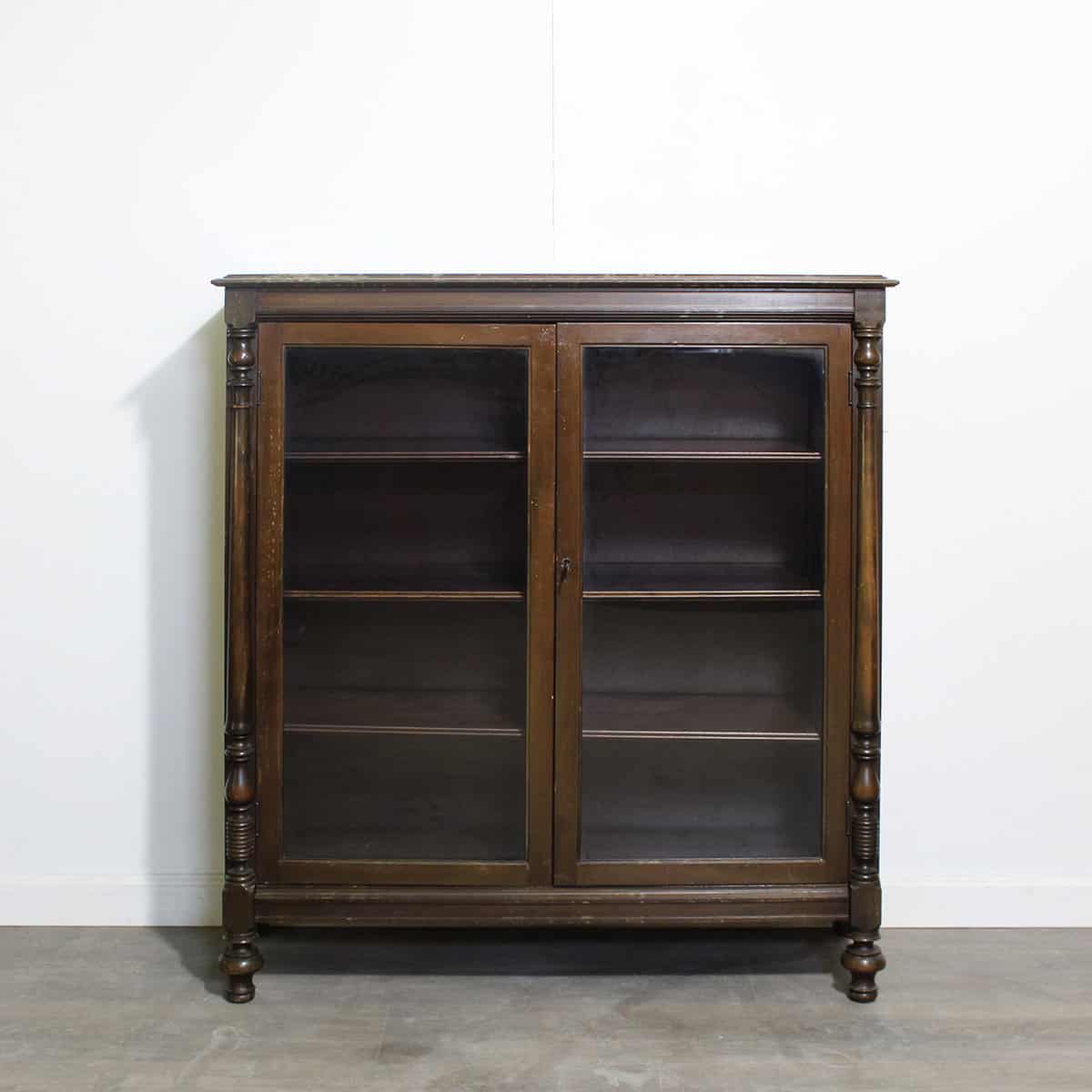
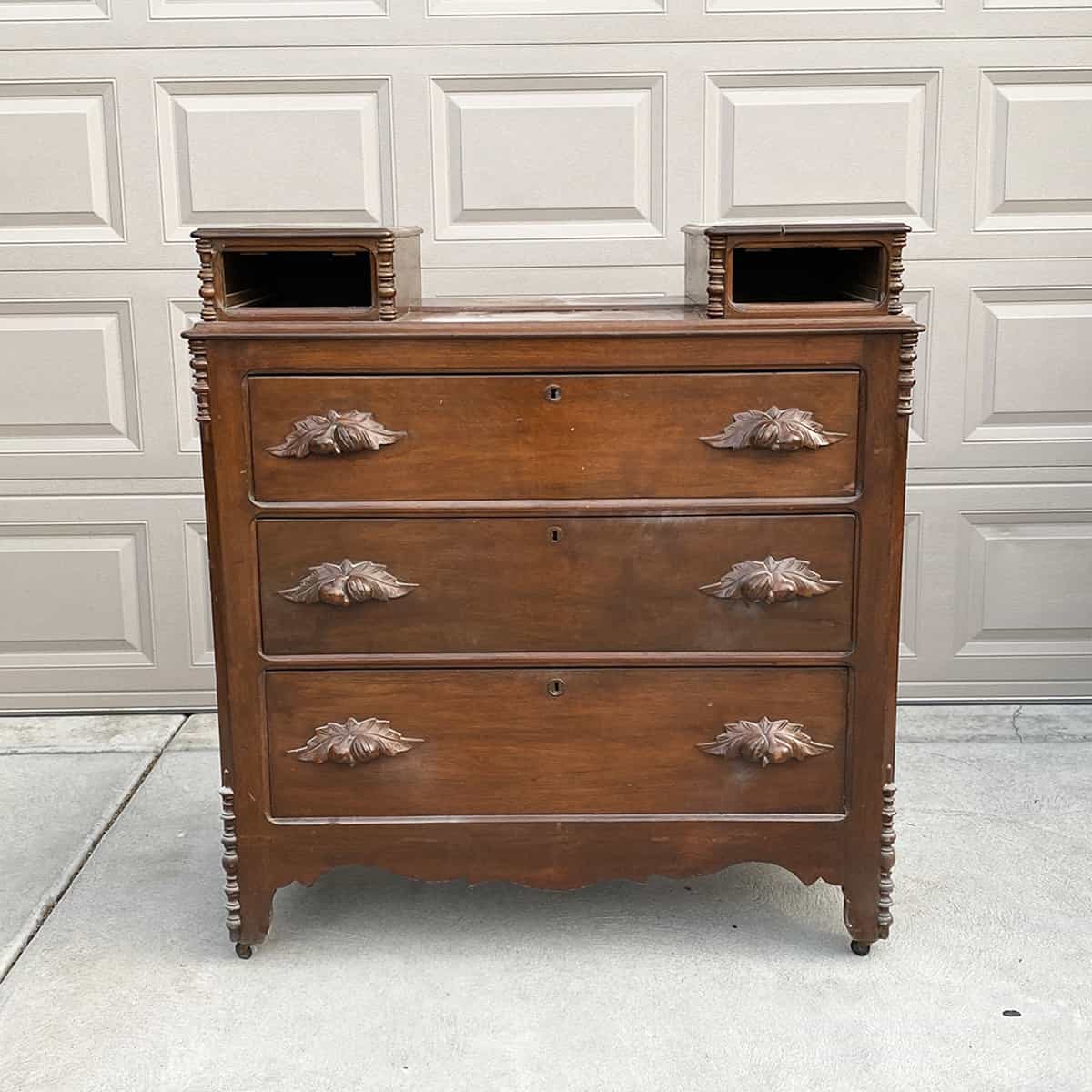
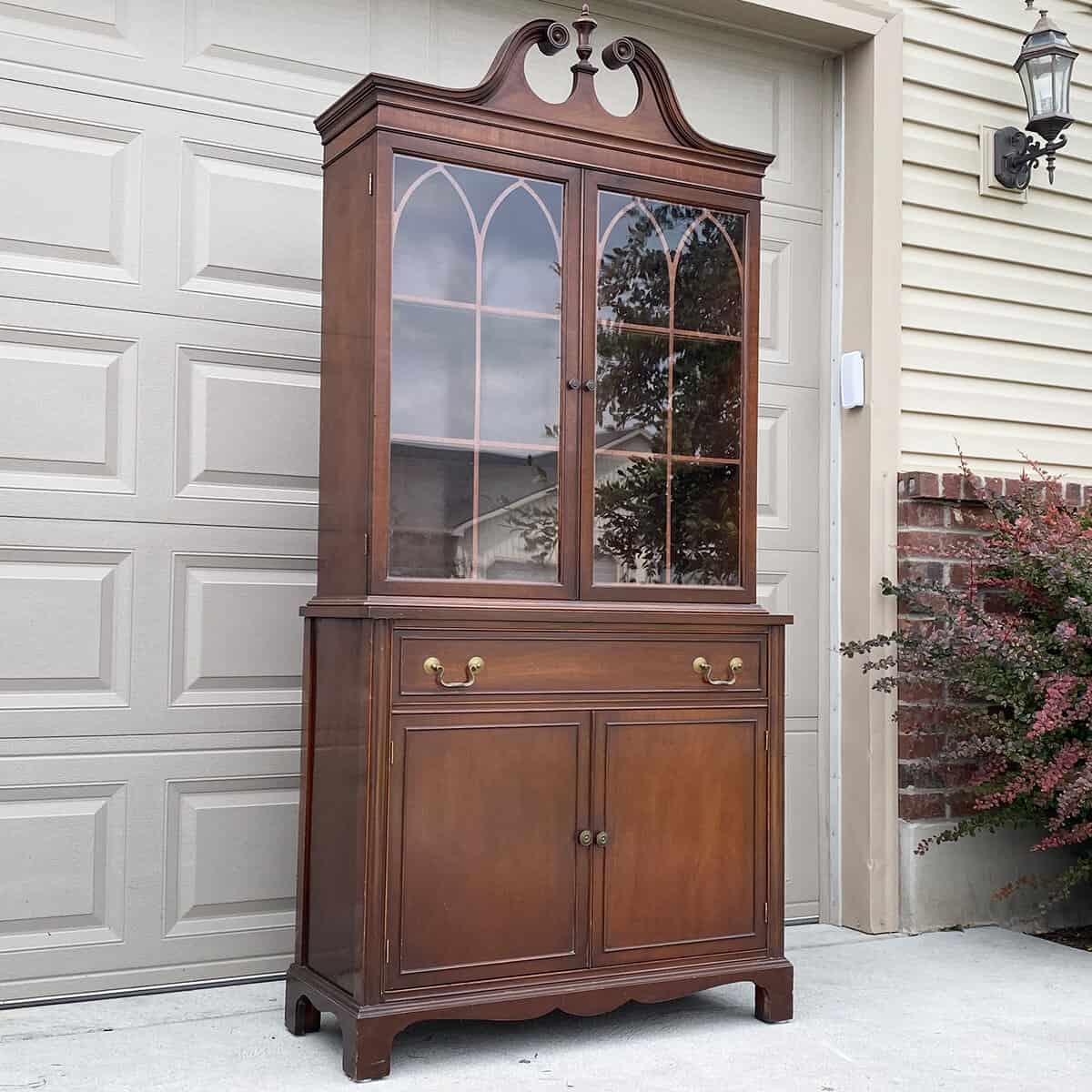
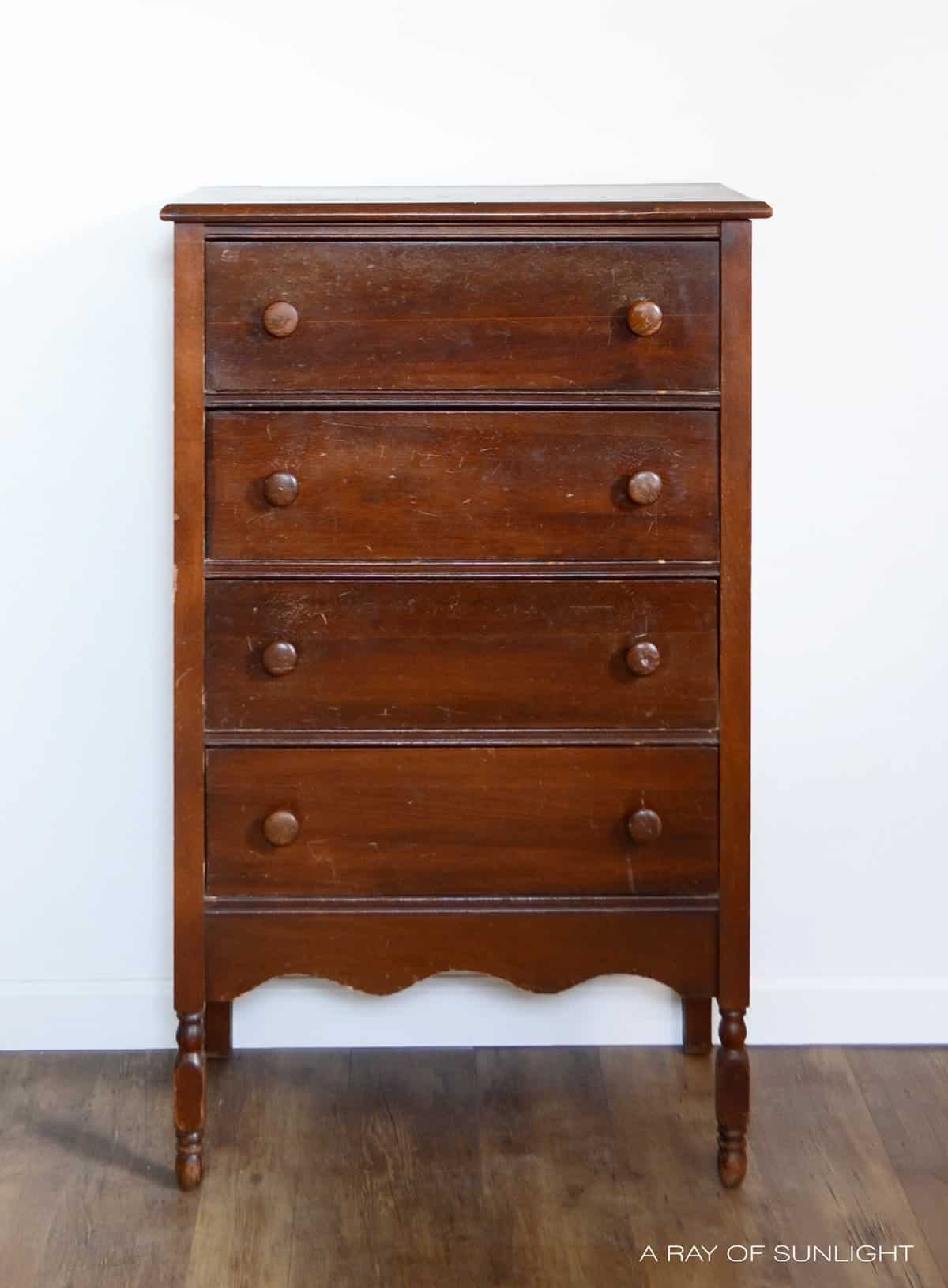
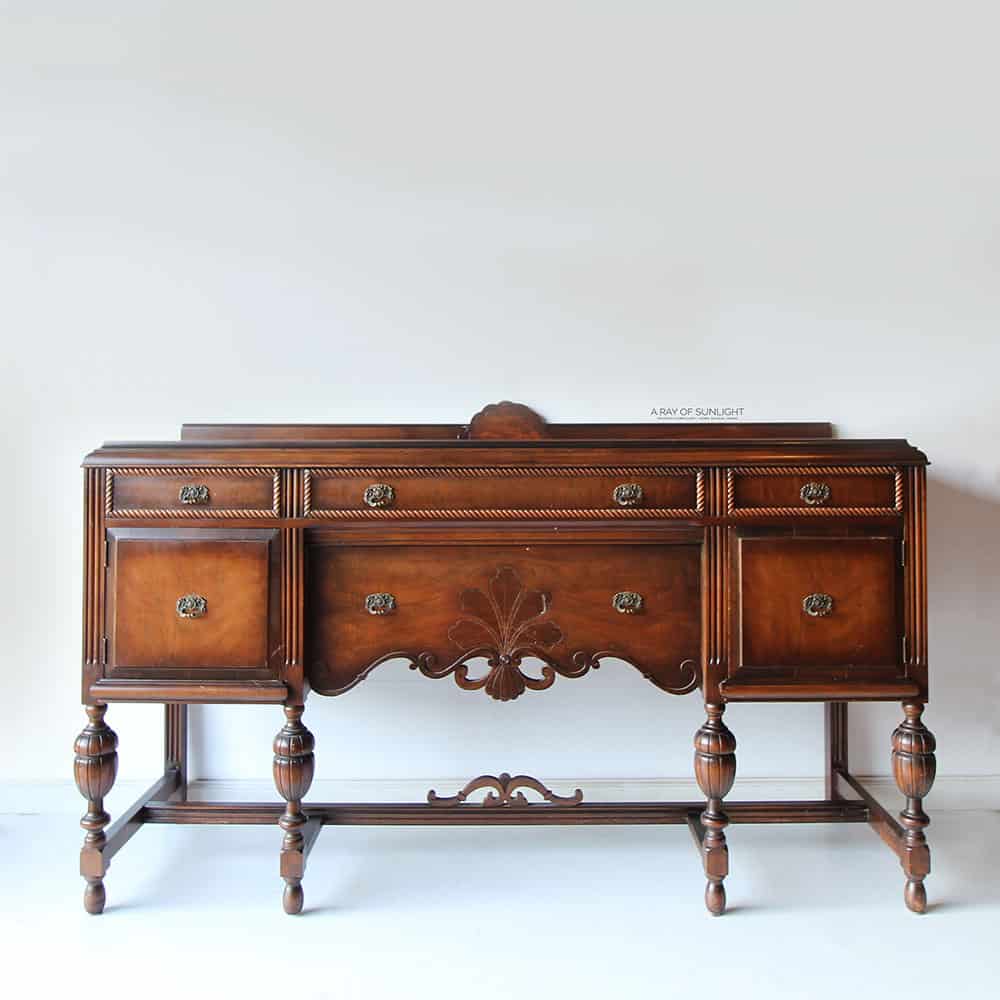
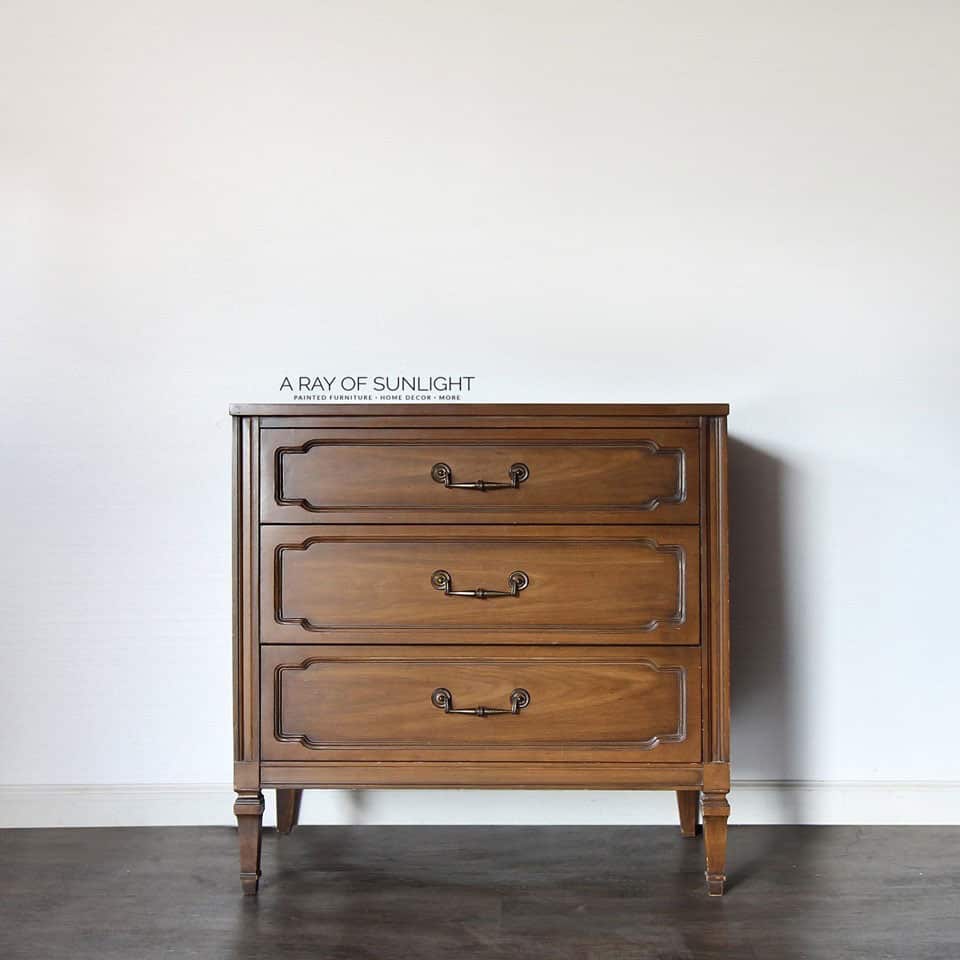
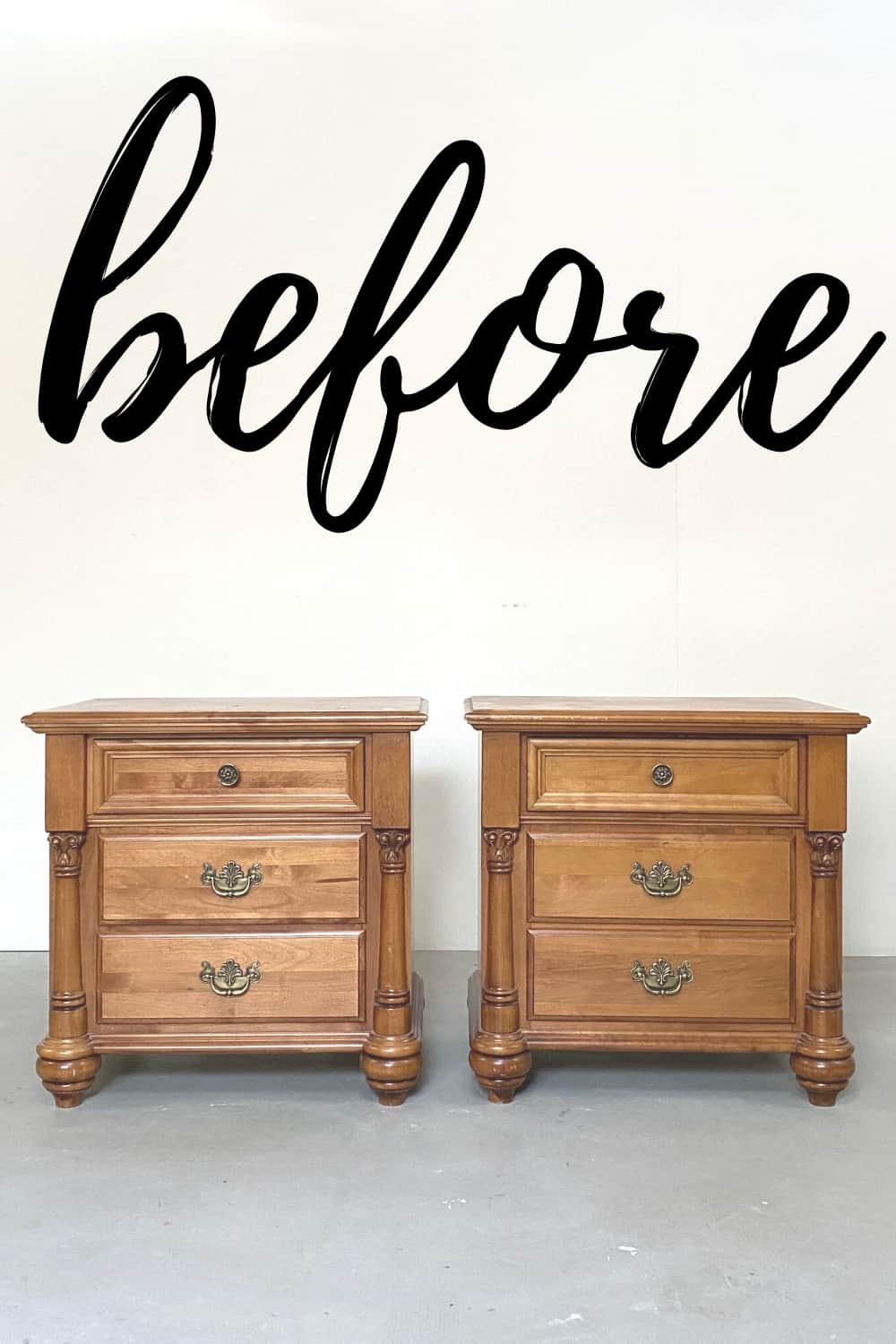
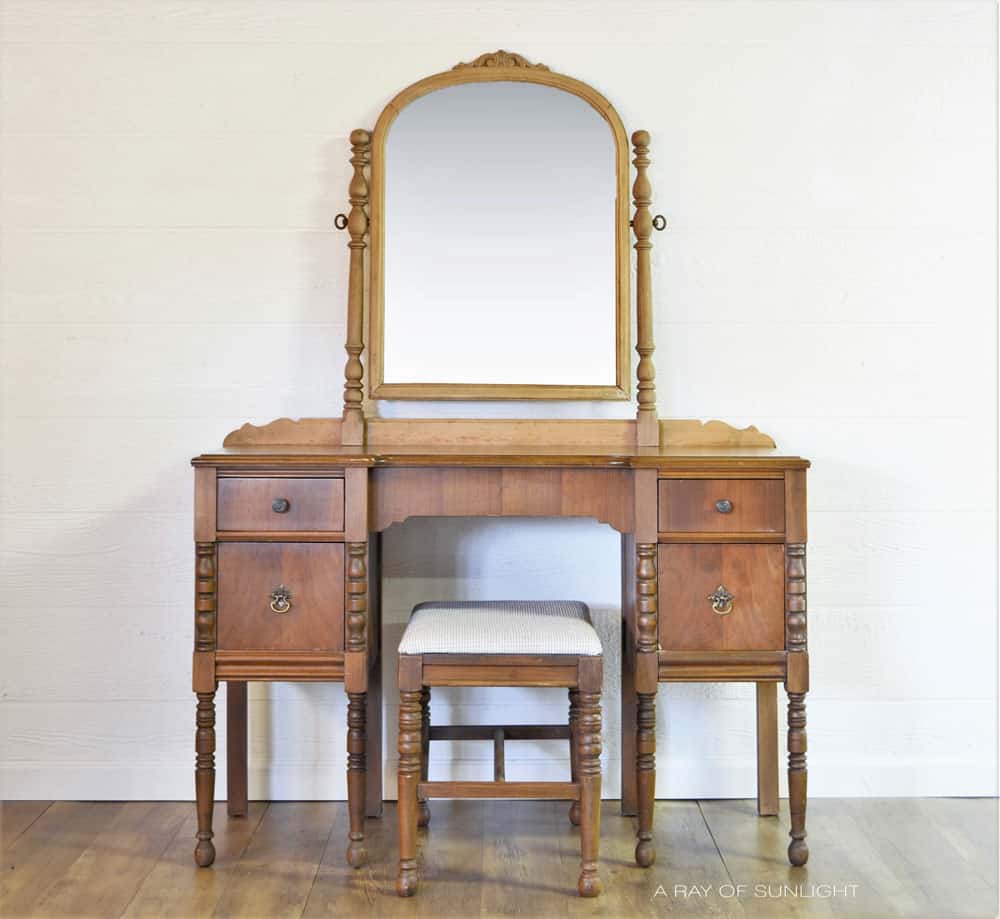
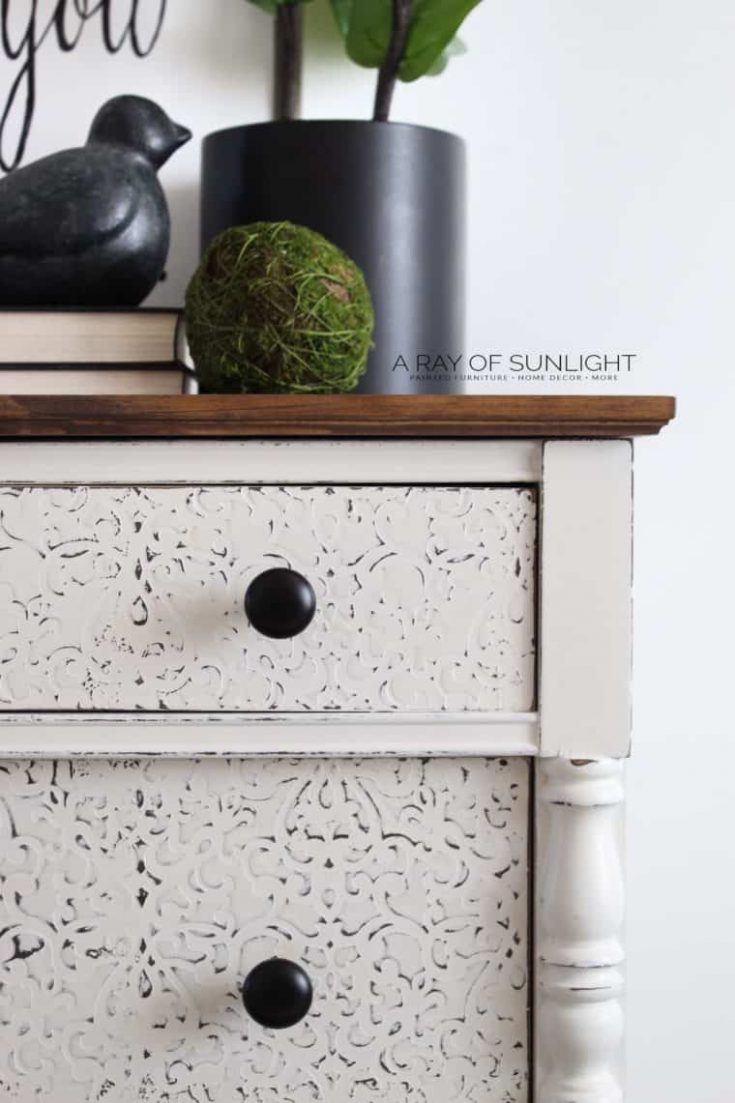

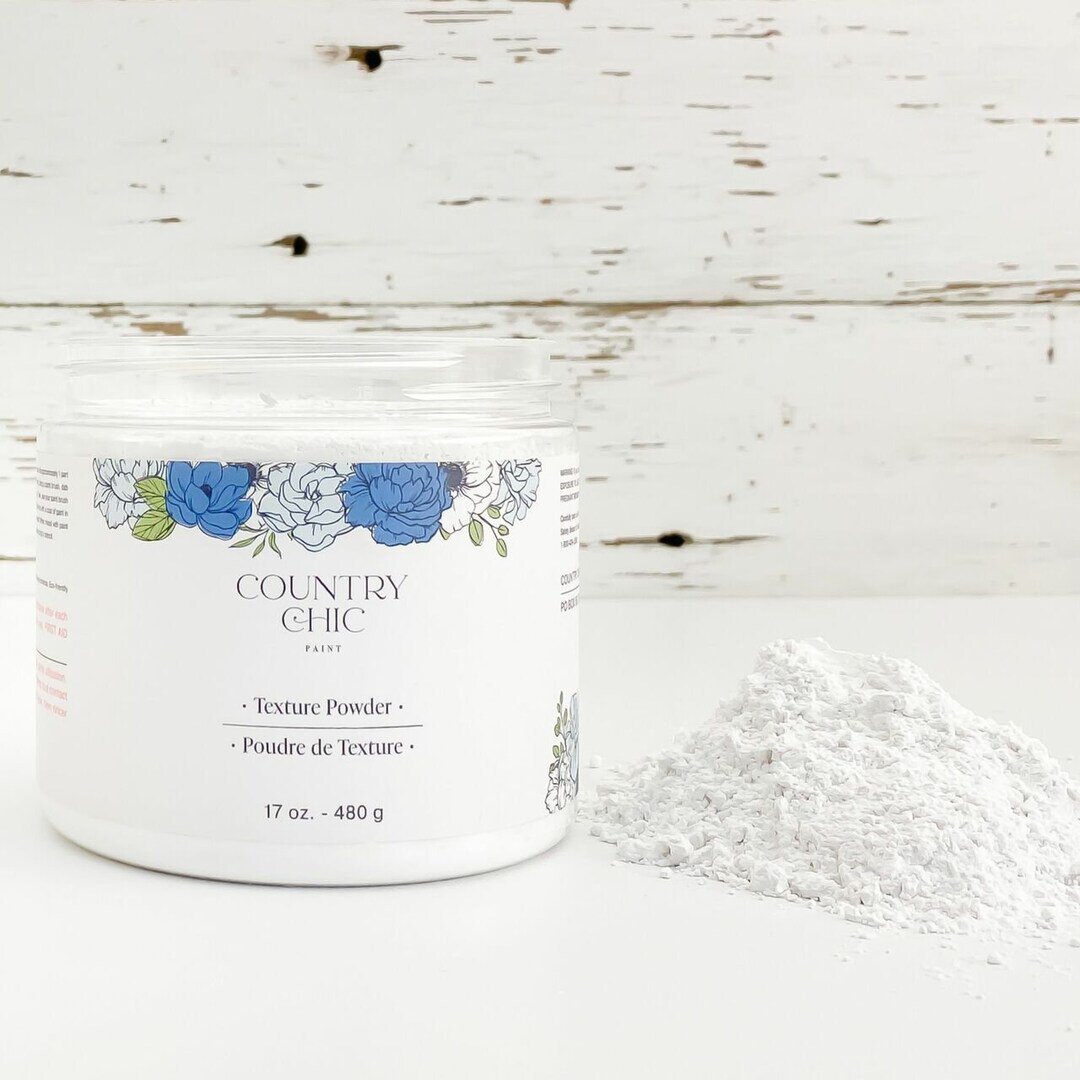
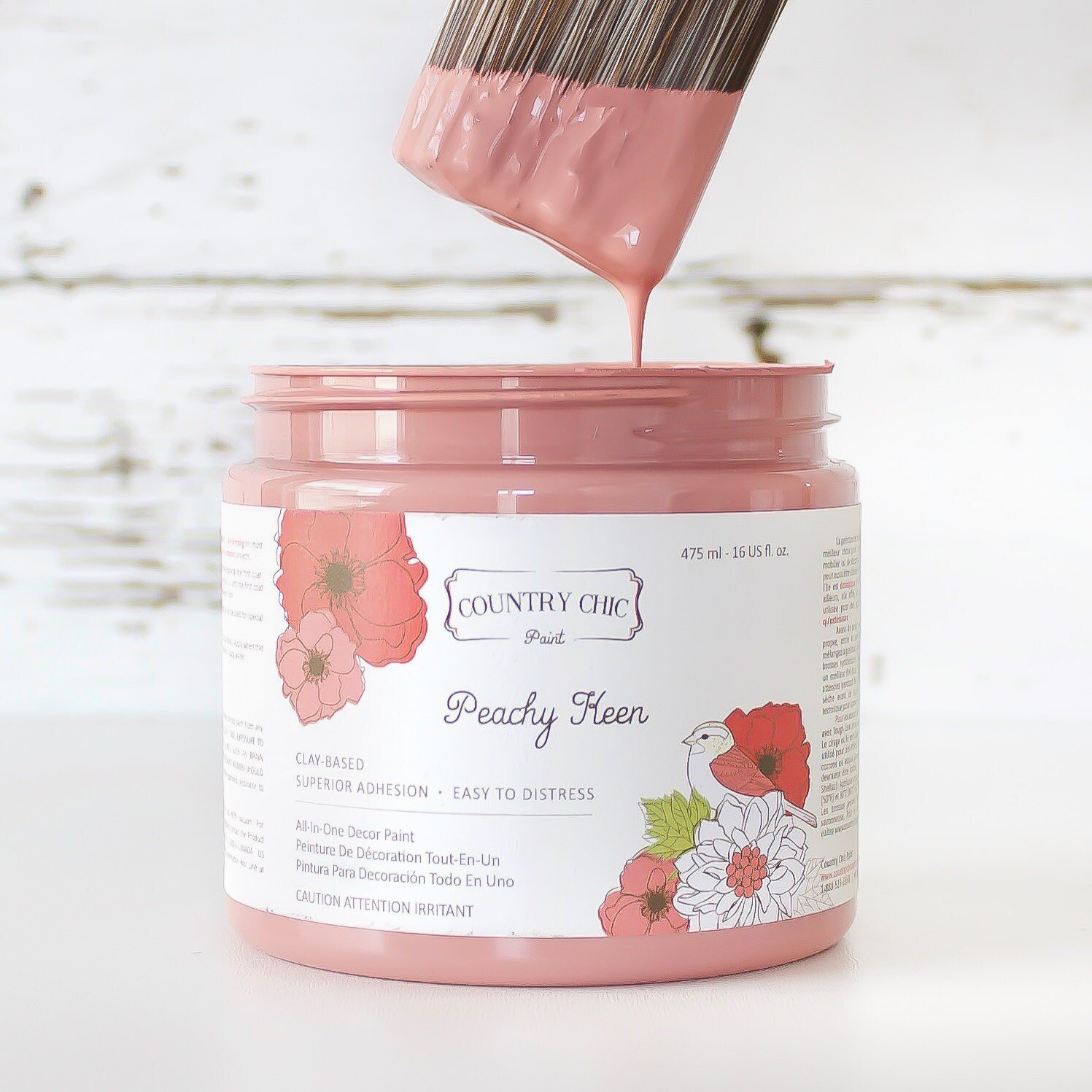
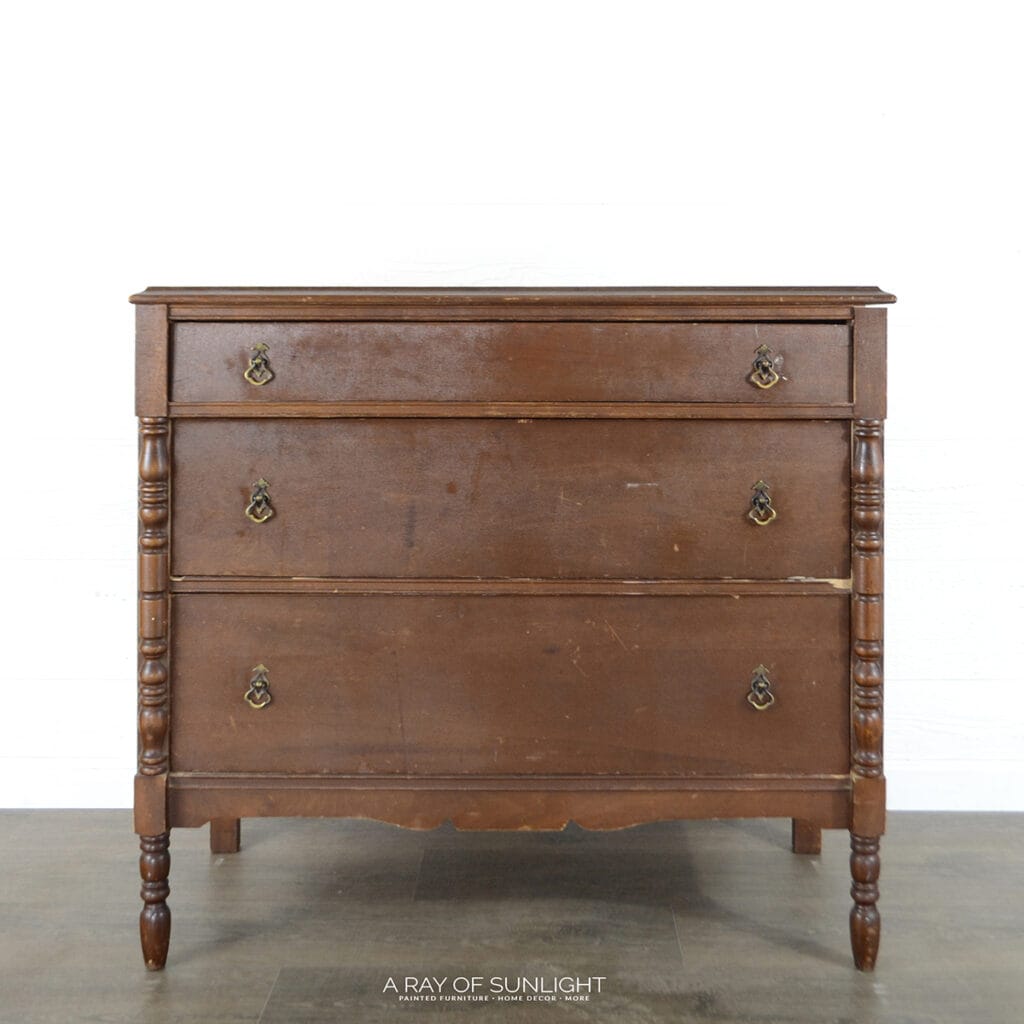
The stained top looks so good with the texture. I have to do this.